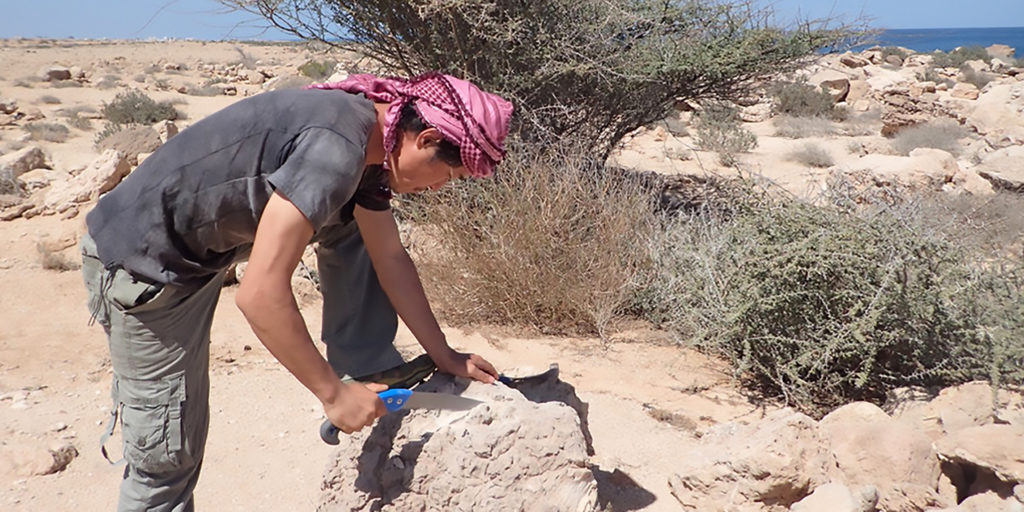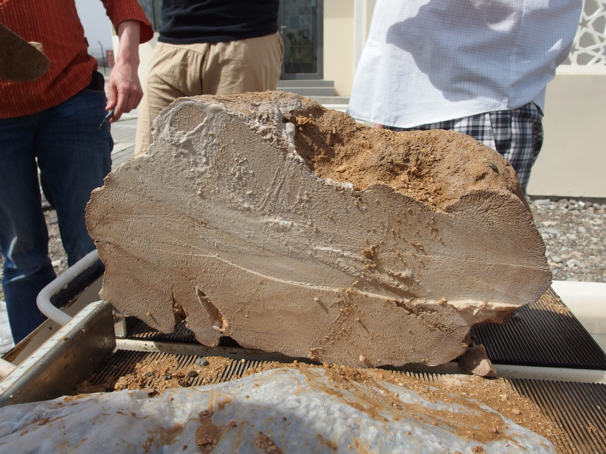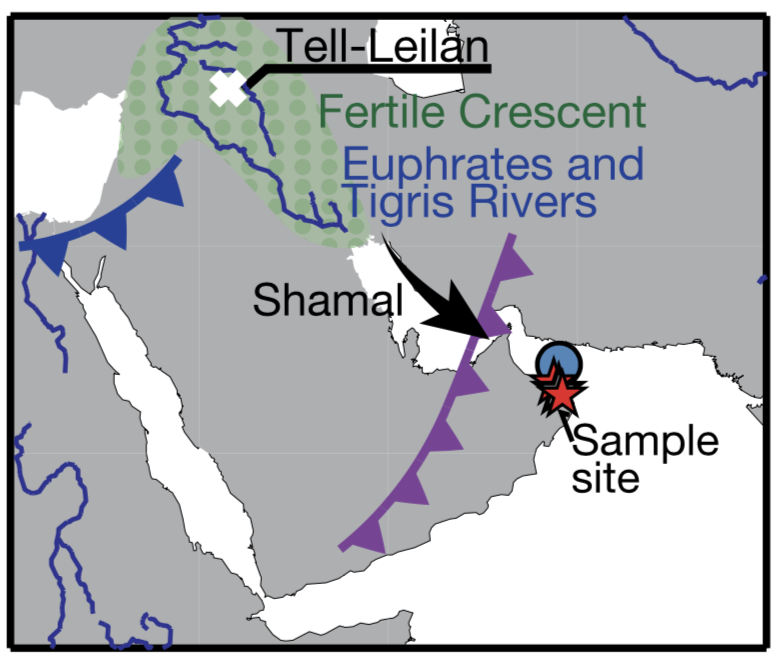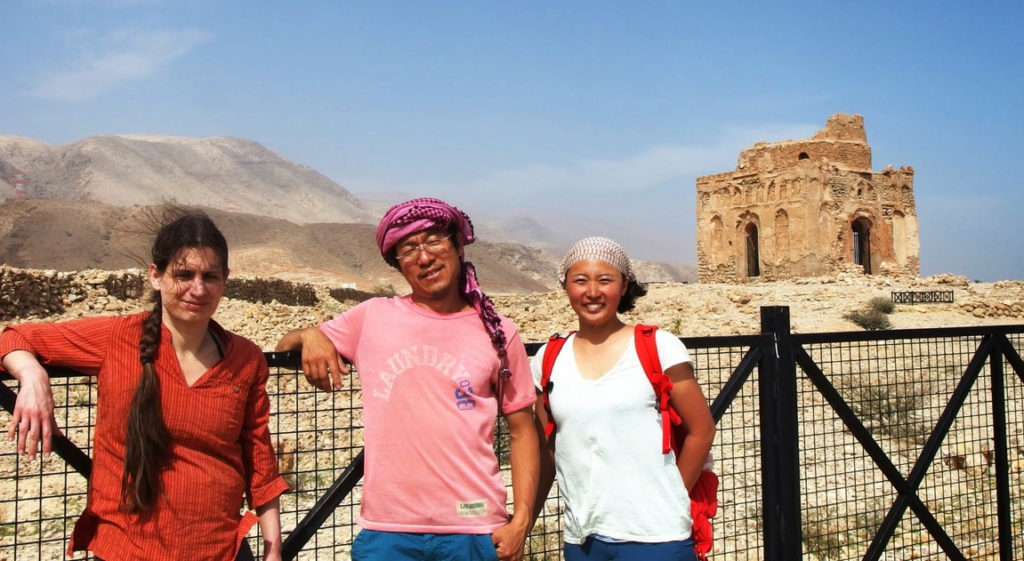
Posted on 10/30/2019 11:43:08 PM PDT by Fred Nerks
Fossil coral records provide new evidence that frequent winter shamals, or dust storms, and a prolonged cold winter season contributed to the collapse of the ancient Akkadian Empire in Mesopotamia.

The Akkadian Empire (24th to 22nd century B.C.E.) was the first united empire in Mesopotamia and thrived with the development of irrigation. Yet, settlements appear to have been suddenly abandoned ca. 4,200 years ago, causing its collapse. The area would also not experience resettlement until about 300 years later.
Past studies have shown that the Akkadian Empire likely collapsed due to abrupt drought and civil turmoil. However, the climatic dynamics which caused widespread agricultural failures and the end of an era have yet to be sufficiently explored.
Researchers from Hokkaido University, the KIKAI Institute for Coral Reef Sciences, Kyushu University, and Kiel University made paleoclimatic reconstructions of the temperature and hydrological changes of the areas around the archaeological site of Tell Leilan, the center of the Akkadian Empire. They sampled six 4,100-year-old fossil Porites corals from the Gulf of Oman, just directly downwind. The samples were aged by radiocarbon dating and geochemically analyzed to confirm they have not been significantly altered from their present state.

4,100-year-old Oman coral fossil
The coral data was then compared to modern coral samples and meteorological information. Although it is normal for the survey area to receive a significant amount of rainfall in the winter, the coral data suggests that, during the time of the empire’s collapse, the area suffered from significant dry spells. The data before and since the collapse are furthermore comparable to modern coral data, showing the dry spells would have been sudden and intense.

Map showing the sample sites (red stars) in respect to Mesopotamia (green dots) and wind direction. (Watanabe T.K. et al, The Geological Society of America. September 2, 2019)
The fossil evidence shows that there was a prolonged winter shamal season accompanied by frequent shamal days. The impact of the dust storms and the lack of rainfall would have caused major agricultural problems possibly leading to social instability and famine, both factors which have been previously associated with the collapse of the empire.
There is a clear correlation between ancient winter climate anomalies (green, blue, and red) and the civilization area of Mesopotamia and the Akkadian Empire (black) via time, with the right-hand side of the graph representing the present day. The anomalies are presented relative to present day values.
“Although the official mark of the collapse of the Akkadian Empire is the invasion of Mesopotamia by other populations, our fossil samples are windows in time showing that variations in climate significantly contributed to the empire’s decline,” said Tsuyoshi Watanabe of Hokkaido University’s Department of Natural History Sciences. “Further interdisciplinary research will help improve our understanding of connections between climate changes and human societies in the past.”

Tsuyoshi Watanabe (center) and his collaborators with the Mausoleum of Bibi Maryam at Qalhat in Oman in the background.
Watanabe T.K. et al., Oman corals suggest that a stronger winter shamal season caused the Akkadian Empire (Mesopotamia) collapse. Geology. October 2, 2019.
DOI: 10.1130/G46604.1
Contacts:
Dr. Tsuyoshi Watanabe
Department of Natural History Sciences
Faculty of Science
Email: nabe[at]sci.hokudai.ac.jp
It’s a cold wind that blows no one any good.
Watanabe is pictured centered. He’s wearing the t-shirt featuring the legend, “laundry’38”.
Where can I get one?
:/
Climate change!!!!
If only they had raised taxes and made government bigger..
Hang on! How can this be??? The internal combustion engine hadn’t been invented yet.And coal fired power plants were still centuries in the future!
Hmmm, that collapse happened before Trump, even Bush. Must be Nixon’s fault when those pesky Russians were helping with Watergate.
ROFLMAO!!!!
They should have gone to electronic cars sooner.
I blame climate change and Trump.
Especially if one is standing down wind!
It was global warming...to much gaseous emission from flatulent camels .
Thanks Fred Nerks! I put in some keywords, best in the context is probably "curse of agade".
|
Thanks Fred Nerks! I put in some keywords, best in the context is probably "curse of agade".
Very interesting
Thank you for posting/pinging
The Baghdad Battery wasn't quite up to the challenge...
An idea of how bad winter dust storms can get.
‘We thought it was the end of the world’: Forty years later, people still remember fear, uncertainty of monumental 1977 dust storm
The dust was blinding.
Carried by powerful gale force winds, dirt piled onto interstates, buried cars and trapped thousands of motorists along Interstate 5 and Highway 58.
Howling winds ripped roofs off houses and stores, knocked out windows, blew in front doors and forced hundreds of people from farming communities south of Bakersfield to flee for shelter.
The force of the wind was so mighty that it sand blasted the paint off cars, pitted chrome bumpers and carved up fence posts.
“It looked like someone dropped an A-bomb on Bakersfield,” Dick Powers, a chief pilot for Continental Telephone Company told The Californian in 1977.
Some children thought it was the end of the world. Instead, it was one of the worst storms in the county’s history — one that conjured up comparisons to the Dust Bowl of the 1930s from which so many fled to Bakersfield to escape.
Forty years ago this week, that monumental dust storm swept into Kern County, leaving a path of destruction in its wake.
The storm, which began Dec. 19, 1977 and lasted three days, left five dead and caused more than $34 million in damages. Gusts up to 192 miles per hour stripped 25 million tons of soil from grazing land and row crops — enough to fill more than 1.6 million standard dump trucks like the ones that drive up and down Highway 99 everyday.
The eye of the storm settled over Arvin. The dust was so thick that the town was pitch black mid-day. A now infamous photo of the storm taken from a twin-engine aircraft shows what appears to be a tidal wave of dirt reaching a height of nearly 5,000 feet moving over the rural farm town south of Bakersfield.
It was caused by an unusual intense high-pressure system over the Rocky Mountains and a low-pressure system off the California coast. Nature moved to fill the vacuum, and Kern County laid between the two pressure systems.
The weather event — which was considered a “once in a lifetime” storm and named one of the top 15 weather events of the century by the National Weather Service — closed portions of all major freeways running through Kern County, stranded motorists and knocked out power.
By the third day of the storm, news had gotten out about the devastating conditions in Kern County, and Gov. Jerry Brown had declared both Arvin and Bakersfield disaster areas.
Reports began surfacing of livestock getting buried alive, canals becoming filled with dirt and almond trees toppling, in some cases wiping out entire orchards and causing millions of dollars in economic losses.
Winds reached 88 mph in Arvin before the anemometer broke the first day of the storm, but the U.S. Geological Survey estimated gusts as fast as 192 mph, according to the National Weather Service.
By comparison, a Category 5 hurricane has sustained winds at 157 mph while an EF-5 tornado generates wind speeds in excess of 261 mph.
LeRoy Schnell, the Arvin Edison water master dispatcher, told The Californian at the time that the wind was shooting gravel through the air the size of peas.
“You’ve never seen anything like this,” he said in a Dec. 20, 1977 article.
When natural disasters strike, the aftermaths are sometimes marked with looting. That wasn’t the case in Kern County, officers told The Californian at the time, save for just a few incidents, including two juveniles who were caught running from a 7-Eleven on White Lane with “an armload of beer.”
Scores of Kern County residents who were around for the storm posted their memories on The Californian’s Facebook page, shared recollections by email and sent handwritten letters to the paper leading up to the 40th anniversary.
Michelle Corson, now a Kern County Public Health spokeswoman, was in third grade at the time in Cummings Valley when the storm hit.
“I remember we got out of school early, and being carried to the bus because the teacher was afraid to let us walk in strong winds,” Corson said. “We thought it was the end of the world!”
Aaron Reynolds, 13 at the time, remembered his mother also thinking the storm was the end of the world. And since Reynolds had it in his head that the dust storm was the rapture, he figured he’d go out with a bang.
“I grabbed my sleeping bag, made my parachute and climbed on the roof,” Reynolds recalled.
He thought he would get swept up in the wind like the Wicked Witch of the West, and to some degree, he was right. The wind did sweep him away, but all that goes up must come down. After a fleeting moment, the wind slammed him across the yard and into a fence.
“The ground broke my fall, and my wrist,” Reynolds said.
It’s a classic case of “boys will be boys,” just like Shane Goslin, who shared on Facebook that he threw his new winter coat in the air.
“Never saw it again,” he wrote. “Mom was mad.”
Ben Stinson, president of Stinson’s Office Supplies, recalled that his father had sent his entire staff home for the day when the duster began kicking up, and shortly after they received a report of a plate glass window shattering.
Stinson, then 21, crawled inside the storefront display on Baker Street to prop a plywood board up when a strong gust came in and shattered three adjacent eight-foot tall plate glass windows from the inside. Glass burst onto the sidewalk.
“If I had been standing there, I would have been dead,” Stinson said. “It was just a powerful force that shattered it, and there were large shards of glass flying in the air.”
The same thing happened at Three-Way Chevrolet on California Avenue, said Venita Sorrell Jones, who was working there at the time. The windows busted and glass burst all over the cars on the showroom floor, she recalled in a Facebook post.
“I worked at Casa De Liqores at 21st and F Street,” Michael Boyt recalled on Facebook. “The wind blew the big plate glass window in and all the others out. They went out of business right then and there.”
Michael Kovacevich, a special projects manager with the Kern County Department of Human Services, who was then 29, shared a story about his late father, John J. Kovacevich, during the storm - when the dust was so thick that it blotted out the sun, and any hope for visibility while driving:
John J. was working in Arvin when the wind kicked up. His office windows exploded inward, and he took it as his sign to head home.
He found Tejon Road and began heading north to get to Edison Highway to get home.
He didn’t make it.
He saw a pair of tail lights ahead of him.
“I figured the guy knew where he was going so I decided to follow him. After about five minutes, going slowly, the road felt a lot bumpier than I remembered it,” John J. Kovacevich said at the time.
Both drivers got out of their cars and looked around, surprised to find they’d both driven about 100 yards into a plowed field.
“We made it back to Tejon and he went his way, north, but I didn’t think I could make it. I turned onto Vineland and made my way to Jack and Mary Lou Thompson’s house. I knocked on the door and they took me in and took damn good care of me until I thought I could make it home, which, about three hours later, I did,” John J. Kovacevich concluded at the time.
The toll the storm took on the health of Kern County residents, and those far beyond, wasn’t in all cases immediate. By the following year, though, the Kern County Public Health Services Department recorded 451 valley fever cases — a 61 percent spike over the previous year. Seven people died.
That’s because more of the Coccidioides fungal spores — which grow throughout the Southwestern United States and cause the respiratory disease when inhaled — were moving around the environment. Some cases were reported as far north as the San Francisco Bay Area, and the dust itself traveled more than 500 miles and into Oregon, according to a report written by now-retired Public Health Lab Director Ronald Talbot.
“It was tremendous,” Talbot recalled in a phone interview from Arizona, where he now resides. “We were doing 1,000 tests a week, and we’d normally been doing maybe 100 or 200 a week.”
Pamela Tarango, then 11, was among those stricken with valley fever, along with her father.
It’s unclear if she breathed in the spore before or after the wind picked her up and dropped her off in her family swimming pool, which was filled with leaves and mud.
Colleen Clasen recalled that lots of bad came out of the storm, but at least one good thing came, she said.
“I got pregnant with my firstborn,” Clasen shared on Facebook. She was born at Bakersfield Memorial Hospital Sept. 16, 1978, Clasen said, along with about 10 others whom doctors and nurses affectionately referred to as “dust storm babies.”

The map for the article shows the winds coming from the Northwest, crossing over the Iraq Marshes and the 2000 BC age probably meteor strike and than continuing to sample site. The timing is right for this to have caused the severe weather results. The Akkadians were not the only civilization in the middle east to go bust around 2000 bc. It really seems to have been the downfall of a number of civilizations.
Disclaimer: Opinions posted on Free Republic are those of the individual posters and do not necessarily represent the opinion of Free Republic or its management. All materials posted herein are protected by copyright law and the exemption for fair use of copyrighted works.